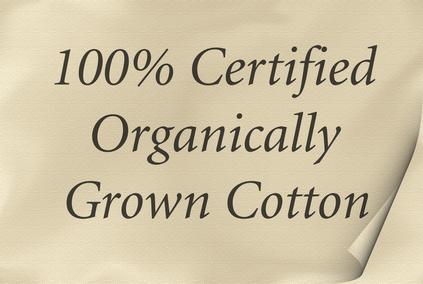Eco Friendly Linens - Choose Organic and Dye-Free Fabrics
When your curtains blow in the breeze, your sheets touch your skin and your tablecloth displays your healthy, organic meals, the last thing you want thrown into the mix are "nanoparticles" from chemically-treated fabric. Unfortunately, that's exactly what you get with most linens sold today. Bottom line, if it's not a natural fabric certified organic, your house is home to these nanoparticles so small they can absorb into your body through your eyes, nose, mouth and skin.

Avoid Dyed and Synthetic Fabrics
Unless you're buying secondhand or vintage items that have presumably been washed repeatedly (diluting the danger of toxic chemicals), avoid conventionally-dyed synthetic linens made from:
- Acetate
- Acrylic
- Nylon
- Polyester
- Polyvinyl Chloride (PVC)
- Rayon
- Triacetate
The personal impact of chemically-treated fabrics on your family's health is only a small part of the larger picture. Not only does the conventional treatment of fabric use a great deal of water but, once used, this chemical-filled water most often finds its way back into our streams and rivers, particularly in other countries where every shortcut is taken to make things cheap.
Buy Natural, Eco-Friendly Materials
Chemical dyes are not necessary to create lovely linens for your home. You don't need "anti-wrinkle" or "stain-resistant" either, as both mean the addition of formaldehyde when you can just as easily get rid of wrinkles and stains the good old fashioned way.
Instead, look for linens made from natural, chemical-free fabrics like:

- Organic Cotton
- Linen
- Bamboo
- Legna (made from sustainably-harvested wood)
- Hemp
- Flax
Beyond that, look for labels that indicate the item is:
- Certified Organic (including the thread)
- Pesticide Free
- Chlorine Free
- Untreated
- Uncolored (or colored with vegetable-based dyes)
- Fair Trade
Of course, if you're buying from a local artisan you may not find these labels on the items they sell. However, you can and should inquire about their materials, sources and manufacturing practices.
Consider Secondhand and Vintage
Though you may prefer brand new, fresh fabrics for things like sheets, blankets, towels and napkins, don't rule out secondhand and vintage curtains, tablecloths and placemats. In these instances, synthetic can make sense as older fabrics have been cleaned so many times that most of the harmful chemicals have been washed away, From rummage sales to antique stores, you should be able to find quality items as gently used as they are unique.
Buy From Local Artisans
Whether you buy them ready-made at the community craft fair or have them custom designed and sewn, linens made by artisans in your community present an ideal way of greening your home decor while supporting your local economy. Just be sure to look for the eco-friendly fabrics and labels referenced above.
Make Your Own
Far less complicated than making your own clothes, linens can be made out of relatively simple patterns for curtains, table cloths, place mats and napkins. And if you have the skill (or want to learn), by all means quilt or crochet your own blankets. Not only does this give you complete control over selection of materials but you're creating handmade family heirlooms that can be passed down for generations to come.
